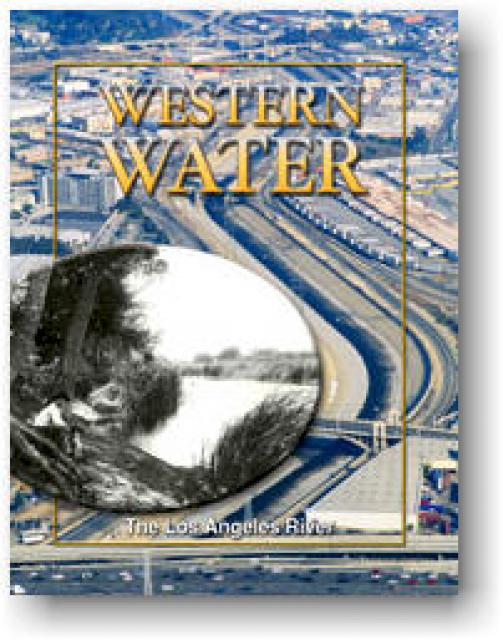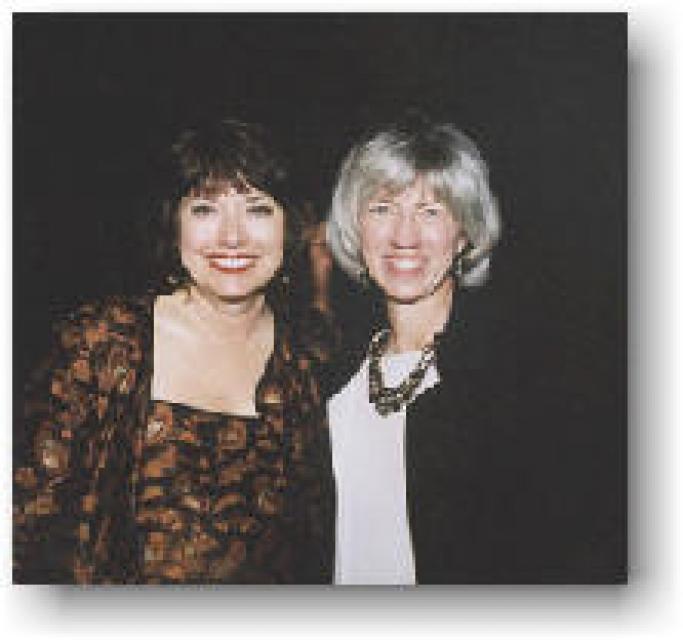The Los Angeles River
Nov/Dec 2003
Introduction
“This spot can be given preference in everything, in soil, water and trees, for the purpose of becoming, in time, a very large plenteous mission.” – Father Juan Crespí, Spanish expedition diarist, describing the Los Angeles River in 1769.
One wonders what Father Crespí would think of the area he so marveled at were he to see the changes that have unfolded the past 234 years. The idyllic scene he and his band of explorers came across has grown from its humble origins to become one of the world’s largest cities and the very representation of California to the rest of the country and the world. The sprawling megalopolis boasts a population that rivals entire states and continues to draw immigrants seeking the promise of the American dream.
The river itself bears little resemblance to the winding waterway that once flowed from the mountains to the sea. Ravaged by repeated floods, local officials, assisted by the federal government, set out to ease the threat posed by the Los Angeles. The result is a river that has been deepened, straightened and lined with concrete for most of its course.
Los Angeles grew in fits and starts since its origin as a small pueblo in the late 1700s. Periodically, new waves of migration arrived, attracted by the vast availability of land. The river carried on as a sort of parenthetical bystander to the flurry of activity occurring by its banks, but it never strayed far from notice, particularly when the arrival of dense storms meant quick, forceful runoff and, ultimately, flooding.
Beguiling in its apparent tranquility most of the year, the river’s face would quickly change under the weight of fast-moving storms. Untold volumes of water, loaded with sediment and debris, would surge downhill, seeking the path of least resistance towards the sea. The once meandering river became a torrent, easily broaching its banks and spreading across the wide, flat terrain. The periodic flooding provided the backdrop for a rich and diverse habitat in which a variety of fish, birds, plants and wildlife thrived.
Floods plagued the city from the beginning, wiping out homes, businesses and farms and sparking efforts to control the flow of the river, which seemed to change course with each inundation. Federal engineers arriving in the 1930s opted to deepen the river and confine its course into a concrete channel to move storm flows through more than a dozen cities and out to sea. The process was long, arduous and expensive, but in the end, the waters were tamed and the city transformed into the focal point of California.
The city’s image as a place of hope and dreams fulfilled solidified throughout the first few decades of the 20th century. The river, meanwhile, edged closer to its final fate as a flood control channel. The engineers and construction workers of the vast project were justifiably proud of their accomplishment upon its completion, and well they should have. After more than 20 years, they had completed what one U.S. Army Corps of Engineers (Corps) official called a “water freeway.”
But the tremendous amount of work that went into making the city safer from flooding also managed, in some people’s minds, to obliterate any trace of the Los Angeles River as a prominent part of the landscape.
“Unless you have business that takes you to the river, you are hard- pressed to find it with a casual look see,” wrote Patt Morrison, author of Rio LA: Tales From the Los Angeles River. “It is too low to be seen from the vantage point of freeways, too trifling to be listed under ‘points of interest’ in the trusty Thomas Guide. For most of its 51 miles, it is as unmarked as a pauper’s grave.”
Since its inception as a flood channel, the river has carried on – fed by the continual supply of treated wastewater and storm drain flows. Near its headwaters in the San Fernando Valley, where only the sides are reinforced, the river is vibrant, full of trees, birds and wildlife. For most of its run, however, the river flows through a concrete box or trapezoid, fenced off from public access. Filmmakers have found it an ideal spot for chase scenes – a killer robot hunted down newly-elected Gov. Arnold Schwarzenegger there in 1991’s Terminator 2: Judgment Day.
More often than not, the river has been the butt of jokes and some truly over-the-top suggestions. Ideas have ranged from painting the paved bottom blue to give it a more river-like appearance to using it as a bypass to alleviate congested roadways.
“In the artificial landscape that is contemporary Los Angeles, where even the palm trees were imported, perhaps nothing symbolizes the role of human beings in changing the face of the earth more than the exploitation and transformation of the Los Angeles River,” wrote Blake Gumprecht, author of The Los Angeles River: Its Life, Death and Possible Rebirth.
But not everyone ignored the river or viewed it as beyond the scope of any focused effort. Slowly, a cadre of committed individuals emerged to champion the cause of the river and to dare to conceive of the idea of returning it to some version of what it once was. Their resources were limited at first, as was the audience, but the message began to take shape. The river drew advocates from the ranks of people from a broad spectrum, including neighbors as familiar with the river as they were the passing freeways.
Emerging during the past decade or so of attention has been the realization that change on the river is possible but is not something that will occur rapidly, given the amount of alteration that took place.
“The bigger picture really is working towards a balance again,” said Melanie Winter, director of The River Project. “That doesn’t mean taking out all the concrete right now with a jackhammer.”
In time, elected officials took up the cause of refocusing on the river – driven by the desire to transform neglected property along its banks into parks and green space. Last year, the Los Angeles City Council Ad Hoc Committee on the L.A. River acknowledged the flood control channel “has saved lives and prevented property damage, but has resulted in a river that is considered an eyesore, and not particularly welcoming to humans and nature.”
Through the years, scientists and engineers have engaged in a discussion regarding new approaches to flood control, not just in Los Angeles, but throughout the country. Finding the nexus between naturalization and flood control is an elusive goal involving several variables.
“In terms of restoring it to a more natural river . . . it could be done; it can be re-engineered and reconstructed . . . but it would be tremendously expensive,” said Jim Noyes, director of the Los Angeles County Department of Public Works.
The fate of the Los Angeles, as well as other waterways in the county, was largely determined during the boom years of the 1940s and 1950s as officials decided that flood control should entail the use of as little land as possible, given the rapid urbanization, Noyes said. As a result, waters were shunted through concrete channels that lie directly adjacent to homes and businesses. Any proposed return to a more naturalized channel would be a significant public policy issue because of the amount of land that would have to be acquired to ensure continued if not greater flood protection, he added.
River revitalization is a multifaceted process involving a cross section of interested parties, including government officials, neighborhood activists and environmentalists. Some are concentrating on property immediately adjacent to the river - using riverside projects in places like San Antonio and Denver as a model. Others peer into the river itself and envision a riparian system resplendent with native trees and wildlife.
“Rivers are great places for people to come and recreate and right now, these concrete channels aren’t very inviting,” said Rick Harter, executive director of the Los Angeles & San Gabriel Rivers Watershed Council. “We need to look at it and say, ‘if we want to be around here 200 years from now, what does it need to look like to sustain a quality standard of living?’”
Gumprecht, assistant professor of geography at the University of New Hampshire, told Western Water that while some restoration could be achieved along portions of the waterway, “it’s impossible to conceive of a truly restored L.A. River,” because in its original condition, “the river flowed when and where it wanted.”
hile all agree that riverside improvement is vital to fostering a sense of stewardship, the bolder step of undertaking dramatic structural changes to the river is a thornier prospect that will not see the light of day until flood control agencies are absolutely sold on the concept.
“We always reaffirm that fact that flood protection has to remain the highest priority,” Harter said. “I think we can move toward the visionary notion of the future but we need to do it in a responsible way.”
Preliminary engineering studies are reviewing the possibility of removing some of the river’s concrete bank and replacing it with an environmentally sound, aesthetic surface that allows for some vegetative growth.
On a broader scale is the call for watershed management, a process that seeks an integrated approach to water quality, supply and flood control in a manner that goes far beyond the banks of the Los Angeles River. Cognizant of the value of water in an area that imports most of its supply, scientists, engineers, policy makers and citizen activists are increasingly aligned behind a strategy that recognizes the need to protect lives and property from flooding, but in a way that more resembles a natural process.
“People are aware of the river as a storm drain, but the next frontier is to truly connect their thinking to the watershed,” said Andy Lipkis, president and founder of TreePeople, an environmental group.
This issue of Western Water examines the Los Angeles River, certainly the most unique waterway in California and perhaps the world because of the degree to which it has been transformed by human hands. Despite the makeover, current efforts are focused on making the river something different; a place not so foreboding, more welcoming and possibly a distant remnant of what existed centuries ago.
NOTE: A complete copy of this 16-page magazine is available from the Foundation for $3. Visit our Products Page and add the November/December 2003 issue of Western Water to your shopping cart.
Editor’s Desk
A momentous occasion I observed recently was the October signing of a major agreement at Hoover Dam among the California water users of the Colorado River. Everyone – all the major stakeholders – were there. It was a great day – a day of “peace on the River” after many years of fighting. And even though there will be future disagreements between the parties, it was good to see an agreement signed by all.
As most of you know, California has been under orders from the Department of the Interior and the six other Colorado River states to return to its 4.4 million acre feet of water use per year. The problem has been that the California parties never clearly divided their respective portions of the water. Therefore, solutions to reduce California’s entire share could not be finalized until this was done.
At Hoover Dam, I had a chance to sit down and speak with Interior Secretary Gale Norton. I asked her a number of questions including one about formation of a Lower Basin Commission to find solutions to Arizona, California and Nevada’s Colorado River issues. She said that the present system has worked fairly well and that, while she’s open to new suggestions and proposals, she believes the tough issues that require Interior to be involved as the Watermaster of the river’s Lower Basin “are largely behind us” with the signing of this agreement.
On the issue of more water development in Colorado, Utah, New Mexico and Wyoming, she believes the Upper Basin will develop its water resources “naturally through time whether people support it [development] or oppose it.” The West, she said, is a popular place where everyone is moving. She supports voluntary agricultural to urban transfers saying, “successful ag to urban transfers are an important part of the future of the West.” She noted that “they have to be done correctly” by working with local communities.
Secretary Norton added, “We can have flourishing agriculture by using some efficiency: lining canals, using better sprinkler systems and those can be financed by the payments from municipalities that tend to have more money available.” There are examples of this type of transaction that has worked for decades and can serve as models, she said. Click here for a full report on my interview.
I recently spoke with another federal official involved in major Western water issues: Assistant Secretary of the Army for Civil Works John Paul Woodley Jr. You also can read my full interview with him on our Special Projects page.
In the News
Agencies Sign Quantification Settlement Agreement on Colorado River Use
Following eight years of negotiations, major southern California water interests, farm irrigators and state and federal officials Oct. 16 signed on to a plan that gradually reduces the state’s draw from the Colorado River, primarily through the transfer of water from farms to homes and businesses.
“This Agreement marks a historic turning point for California and the Colorado River Basin States,” Interior Secretary Gale Norton said after signing the pact with officials of four California water agencies. “The economy and wellbeing of a large part of the growing West rely on critical agreements, such as this one, that allocate Colorado River water, provide assurances of long-term supplies, and clear the way for market-based transfers and other tools that are essential to meet the growing water needs of the region.” (See Rita’s letter for more on Norton’s remarks.)
The linchpin of the Quantification Settlement Agreement (QSA) is a water transfer between the Imperial Irrigation District (IID) and the San Diego County Water Authority (SDCWA) that represents a new supply of 12.9 million acre-feet for San Diego over the 75-year term of the deal. The transfer had been a prickly issue with IID, which feared the consequences on the local economy with land taken out of production. IID, which irrigates farms that produce more than $1.2 billion in annual revenue, uses the majority of the water taken from the Colorado by the state of California.
“The last 10 months of negotiations has given IID assurances that socioeconomic impacts of fallowing will be addressed with significant revenues, conserved water created by fallowing will be reduced and we will have protection from challenges to our water use,” said Bruce Kuhn, the swing vote on the IID board’s approval of the QSA The QSA paves the way for California to ramp down to its legal draw of 4.4 million acre-feet of Colorado River water during a 15-year span. (The state has been using as much as 5.3 million acre-feet a year.) SDCWA will pay as much as $258 per acre-foot for the transferred water.
The transfer’s potential impact on the Salton Sea has been addressed through new laws that establish a Salton Sea restoration fund and a memorandum of agreement with Interior seeking federal aid in the restoration effort. “It appears the state is committed to getting the job done but how it maps out, we don’t know,” said Salton Sea Authority Executive Director Tom Kirk, adding that the sea “is in a more certain position now than it’s ever been.”
The water transfer could cause a further draw down on Lake Mead as Nevada’s surplus take of the Colorado is restored. As the state requires more water to fuel the booming growth in its southern portion, the lake could drop 1 to 2 feet annually for the next 15 years, according to the Bureau. Nevada water officials believe increased water conservation measures, including limited lawn irrigation, will lessen the demand for water.







